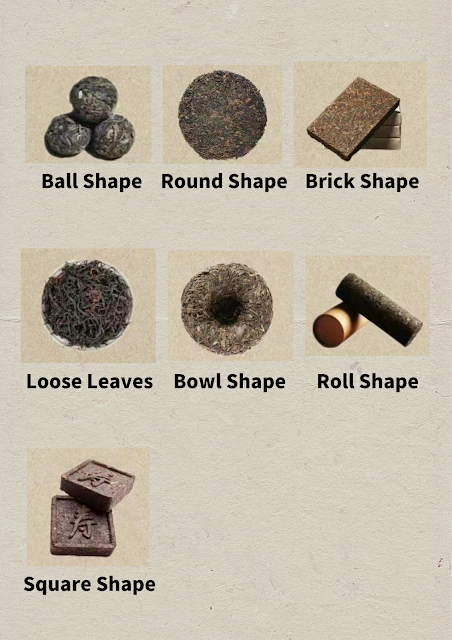Pu-erh tea was born in the famous tea production area Yunnan province. The earliest history of Pu-erh tea can be traced back to Eastern Han Dynasty, as a special fermented tea with unique flavor and aroma, it is favored by more and more people.
*The history of Pu-erh
tea
In order to exchange war
horses with ethnic minorities, the government set up the tea and horse exchange
market of "Tea for Horses", and for convenient of transport, Pu-erh
tea was made into compressed tea and sold to the Sichuan and Tibet regions,
giving rise to the Ancient Tea Horse Road. In the Yuan Dynasty, it was
officially named "Pu-erh Tea" and was one of the most important
commodities traded in the market; from the Ming Dynasty to the mid-Qing
Dynasty, it was the golden age of Pu-erh Tea.
Nowadays, the common
shapes of Pu-erh tea are as follows, round compress shape, square compress
shape, bowl compress shape, ball compress shape, roll compress shape.
According to its
processing process and quality characteristics, it is divided into raw Pu-erh
tea and fermented Pu-erh tea, this classification method is one of the most
common ways to classify Pu-erh tea.
-Raw Pu-erh tea: Made
with Yunnan large-tea plant fresh leaves, after fixation, rolling, sun drying and
so on processes, including loose leaf tea and compress tea.
-Fermented Pu-erh tea: Made with Yunnan large-tea plant sun dried tea, after piling process and fermented. It also has loose leaf tea and compress tea.
*How to select Pu-erh teaTo distinguish
good or bad Pu-erh tea, it is mainly based on four points: tenderness, color,
evenness and stretchiness. Finger pinch Pu-erh tea leaf soft and tough with
good tenderness and hard quality, let go and loosen means old leaf quality,
good quality Pu-erh tea leaves will be very flat after boiling water brewing;
while poor quality Pu-erh tea, only partially unfolded, and looks wrinkled and
uneven, good Pu-erh tea leaf foliage fundus fresh, soup color is yellow-green
and translucent.
*How
to select Pu-erh tea if we cannot try
-Material
A high-quality
Pu-erh tea mainly using Yunnan large-leaf tea plant to produce, picked with one
bud and two or three leaves.
-Shape
Tea
leaves tight and heavy, smooth and moist color, green-black for raw Pu-erh,
red-brown for fermented Pu-erh.
-Aroma
Lotus
fragrance: Lotus fragrance means that Pu-erh tea has a fragrance similar to
that of lotus leaves. It is mostly found in loose tea made from sun fixation
bud tea.
Camphor
fragrance: Camphor is a substance that contains linalool in Pu-erh tea, which
can only be released after fermentation. It is usually fermented ripe tea or
long aged raw teas and raw tea that has been stored.
Orchid
fragrance: The most precious aroma in Pu-erh tea. Orchid fragrance is a
combination of lotus fragrance and camphor fragrance. Generally, Pu-erh tea
made with Grade 3, Grade 4 and Grade 5 tea green will have a refreshing orchid
aroma.
*How to brew Pu-erh tea
Generally, we would use
7g of Pu-erh tea with 100ml of water to brew. And raw Pu-erh tea and fermented Pu-erh
tea would have a little different in brewing. Fermented Pu-erh tea needs to be
rinsed twice before brewing, the first time should be quick brew and quick out;
the second time should be brewed according to the tightness and looseness of
the tea leaves, usually tightly pressed Pu-erh tea is 20-30s, loose leaf Pu-erh
tea is 5-10s.
And raw tea should be rinsed one time in most cases, the first bubbles are generally brewed as they come out, the sixth bubble onwards to extend the steeping time accordingly.
*Pu-erh tea shelf life
Pu-erh is divided into
Green Pu-erh and Dark Pu-erh, Dark Pu-erh is fermented through the piling
process, artificial fermentation has altered many of the material components in
the tea leaves, and in the subsequent storage process, the shelf life is
definitely not as long as that of raw Pu-erh tea, generally within 10 years of
shelf life.
Green Pu-erh has not undergone
any artificial fermentation. It has a shelf life of at least 15 to 20 years. It
is possible to achieve a shelf life of over 30 years for slow converting Green Pu-erh.
*How to store Pu-erh tea
-Avoid sunlight &
odors, store in a dry, cool & ventilated place.
-Store the unwrapped tea
cakes in cartons or kraft paper bags.
- If you have a large amount of tea, separate the raw and ripe tea
and put them into boxes.
-Ripe Pu-erh tea and raw
Pu-erh tea should be stored separately because most of the raw Pu-erh tea are
pekoe, lotus, clear, chestnut and aged aroma; and fermented Pu-erh tea are
ginseng, bean, aged, date, camphor aroma.
As one of China's
traditional famous teas, Pu-erh tea has a long history and cultural heritage.
It is rich in nutrients and has a variety of health benefits. In order to enjoy
good Pu-erh tea, we need to pay attention to purchasing, brewing skills. It is
also very important to store and maintain Pu-erh tea to ensure its quality and
taste.



Comments